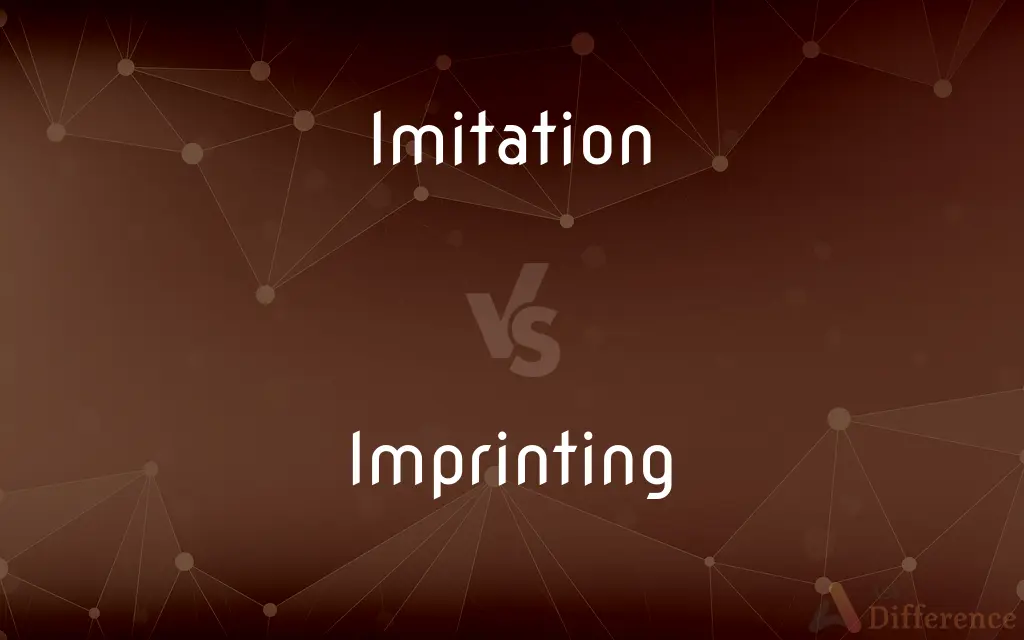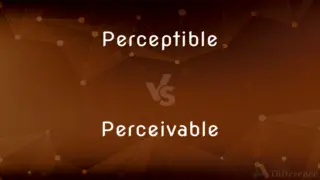Imitation vs. Imprinting — What's the Difference?
By Tayyaba Rehman — Updated on September 26, 2023
"Imitation" is the act of copying or mimicking behaviors, actions, or appearances. "Imprinting" is an innate rapid learning process typically seen in young animals bonding to a particular stimulus.

Difference Between Imitation and Imprinting
Table of Contents
ADVERTISEMENT
Key Differences
"Imitation" and "Imprinting" may both involve the replication of behaviors, but they originate from distinctly different processes and motivations. "Imitation" refers to the conscious or subconscious act of emulating or copying someone or something. Whether it's a child mimicking their parent's speech or an artist recreating a masterpiece, imitation is influenced by observation and practice. It often serves as a method of learning, allowing individuals to adopt and adapt behaviors seen in others.
On the other hand, "Imprinting" is a type of rapid and relatively irreversible learning process that occurs at a specific time in an animal's life, typically soon after birth or hatching. This instinctual process sees young animals, like ducklings or goslings, form attachments to the first moving object they see, often their parent. Imprinting ensures that the offspring stay close to their caregiver, increasing their chances of survival.
While "Imitation" is broadly applicable across various contexts from arts to behavioral sciences, "Imprinting" is a term rooted in biology and ethology. Imitation can be seen in humans and animals alike, driven by social learning, while imprinting, though primarily associated with animals, has also been used metaphorically to describe deep and lasting impressions on humans, especially during their formative years.
In essence, "Imitation" focuses on copying behaviors, actions, or appearances, often driven by learning or social influence. In contrast, "Imprinting" is an inherent mechanism that leads to a lasting bond or preference based on early experiences. Both are influential in shaping behaviors, but they stem from different origins and serve unique purposes.
Comparison Chart
Nature
A learned behavior through observation.
An innate, rapid learning process in early life.
ADVERTISEMENT
Purpose
To emulate or copy behaviors, actions, or appearances.
To form a bond or attachment to a particular stimulus.
Examples
Mimicking speech, replicating art.
Ducklings following their mother.
Domains
Behavioral sciences, arts.
Ethology, biology.
Application
Humans and animals.
Primarily animals during specific life stages.
Compare with Definitions
Imitation
Mimicking behaviors or patterns observed in others.
Young children learn through imitation.
Imprinting
A lasting impression or influence deeply rooted from early experiences.
Her first love left an imprinting effect on her heart.
Imitation
A thing intended to simulate another thing.
The jewelry was merely an imitation of gold.
Imprinting
The process by which certain animals form strong attachments during an early-life critical period.
Due to imprinting, the duckling thought the dog was its mother.
Imitation
A reproduction or replication that falls short of the original.
The handbag was a cheap imitation of the luxury brand.
Imprinting
The phase in certain animals' development when they can acquire specific behaviors.
The chick's imprinting phase made it follow the first moving object it saw.
Imitation
The emulation of a method or strategy to achieve similar results.
He succeeded in business through the imitation of proven strategies.
Imprinting
To produce (a mark or pattern) on a surface by pressure.
Imitation
Imitation (from Latin imitatio, "a copying, imitation") is an advanced behavior whereby an individual observes and replicates another's behavior. Imitation is also a form of social learning that leads to the "development of traditions, and ultimately our culture.
Imprinting
To produce a mark on (a surface) by pressure.
Imitation
The act or an instance of imitating
Gave us his imitation of a famous actor.
Imprinting
To impart a strong or vivid impression of
"We imprint our own ideas onto acts" (Ellen Goodman).
Imitation
Something derived or copied from an original, often in an inferior way
An undrinkable imitation of real lemonade.
Imprinting
To fix firmly, as in the mind
He tried to imprint the telephone number in his memory.
Imitation
Repetition of a phrase or melody often with variations in key, rhythm, and voice.
Imprinting
To cause (a very young animal) to recognize and be attracted to another animal or to an object identified as the parent. Often used with on.
Imitation
Repetition of a theme in another voice such that each part continues polyphonously.
Imprinting
To modify (a gene) chemically, as by DNA methylation, affecting the gene's expression in offspring.
Imitation
Made to resemble another, usually superior material
Imitation fur.
Imprinting
To become imprinted on another animal or on an object identified as the parent. Used of newborn or very young animals. Often used with on
Lab animals that imprint on researchers.
Imitation
The act of imitating.
Imprinting
A mark or pattern produced by imprinting; an impression.
Imitation
A copy or simulation; something that is not the real thing.
Imitation leather
Imprinting
A distinguishing influence or effect
Spanish architecture that shows the imprint of Islamic rule.
Imitation
The act of imitating.
Poesy is an art of imitation, . . . that is to say, a representing, counterfeiting, or figuring forth.
Imprinting
A chemical modification of a gene affecting the gene's expression in offspring.
Imitation
That which is made or produced as a copy; that which is made to resemble something else, whether for laudable or for fraudulent purposes; likeness; resemblance.
Both these arts are not only true imitations of nature, but of the best nature.
Imprinting
A publisher's name, often with the date, address, and edition, printed at the bottom of a title page of a publication.
Imitation
One of the principal means of securing unity and consistency in polyphonic composition; the repetition of essentially the same melodic theme, phrase, or motive, on different degrees of pitch, by one or more of the other parts of voises. Cf. Canon.
Imprinting
A publishing business with a unique name, usually owned by a larger publishing firm
Started a paperback imprint for young-adult novels.
Imitation
The doctrine that representations of nature or human behavior should be accurate imitations
Imprinting
Any kind of phase-sensitive learning (learning occurring at a particular age or a particular life stage) that is rapid and apparently independent of the consequences of behavior.
Imitation
A copy that is represented as the original
Imprinting
Present participle of imprint
Imitation
Copying (or trying to copy) the actions of someone else
Imprinting
The learning of a behavioral pattern that occurs soon after birth or hatching in certain animals, in which a long-lasting response to an individual (such as a parent) or an object is rapidly acquired; it is particularly noted in the response of certain birds to the animal they first see after hatching, usually the parent, as in ducks who will follow the adult duck they first see.
Imitation
A representation of a person that is exaggerated for comic effect
Imprinting
A learning process in early life whereby species specific patterns of behavior are established
Imitation
Not genuine or real; being an imitation of the genuine article;
It isn't fake anything; it's real synthetic fur
Faux pearls
False teeth
Decorated with imitation palm leaves
A purse of simulated alligator hide
Imprinting
A rapid learning process in young animals that establishes behaviors toward specific stimuli.
The goslings' imprinting on the researcher was evident as they followed him everywhere.
Imitation
The act of copying or reproducing someone's actions, appearance, or words.
Her singing was a flawless imitation of the original artist.
Imprinting
A mechanism ensuring offspring recognize and follow their caregivers.
Imprinting ensures chicks stay close to their mother hen.
Common Curiosities
Is imprinting limited to birds?
No, while often cited in birds, imprinting is observed in various animals, including mammals.
What is the primary purpose of imitation?
Imitation primarily serves as a method of learning by emulating behaviors or appearances.
Can imitation be both conscious and subconscious?
Yes, imitation can be a deliberate act or an unintentional behavior.
Is imprinting reversible?
Imprinting is generally considered rapid and relatively irreversible.
Do humans exhibit behaviors of imitation?
Yes, humans often learn and adapt through imitation, especially during childhood.
Share Your Discovery

Previous Comparison
Perceptible vs. Perceivable
Next Comparison
Provable vs. ProbableAuthor Spotlight
Written by
Tayyaba RehmanTayyaba Rehman is a distinguished writer, currently serving as a primary contributor to askdifference.com. As a researcher in semantics and etymology, Tayyaba's passion for the complexity of languages and their distinctions has found a perfect home on the platform. Tayyaba delves into the intricacies of language, distinguishing between commonly confused words and phrases, thereby providing clarity for readers worldwide.
















































